6 Garden Ideas for Transforming Side Yards
Just like Alice’s discovery of a hidden garden, your side yard holds untapped potential waiting to be transformed into something magical. You’ll find that these narrow spaces between homes offer surprising opportunities for creating charming retreats, practical storage solutions, and vibrant growing areas. From serene meditation corners to vertical herb gardens, you’re about to explore six creative ways to turn that forgotten strip of land into your property’s most enchanting feature.
Contents
Create a Charming Herb Garden Path
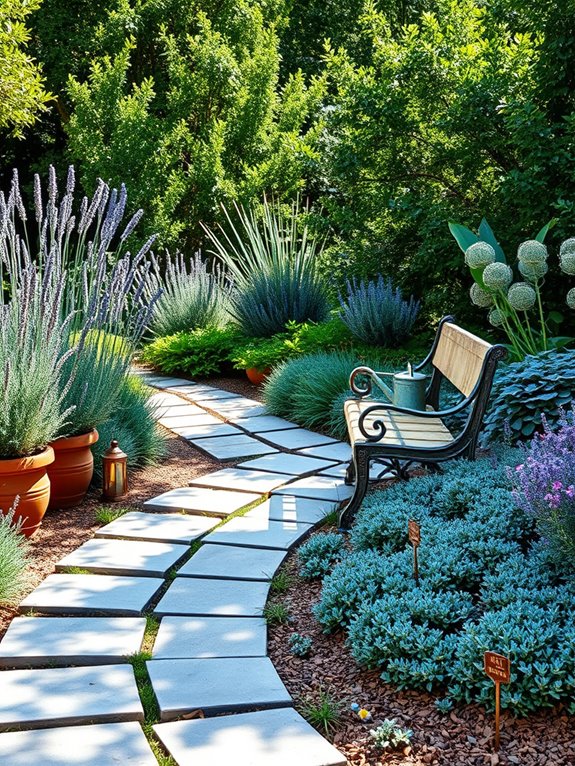
Transform your side yard into a sensory journey with a winding herb garden path that combines beauty and functionality. Stepping stones meander through clusters of fragrant herbs like lavender, thyme, and sage, creating an enchanting pathway that releases aromatic oils with each footstep. Traditional herbs mingle with ornamental varieties, offering a tapestry of textures from soft, silvery artemisia to the deep purple spikes of flowering sage.
The path edges burst with cascading rosemary and creeping thyme, softening the transition between walkway and garden bed. Interspersed decorative elements like weathered terra cotta pots, vintage watering cans, and small garden statuary add whimsical charm while providing focal points along the journey. The varied heights of herbs create visual interest, from low-growing oregano to tall, swaying fennel fronds that catch the afternoon light.
Key Elements:
- Stepping stones or pavers
- Mixed herb varieties (culinary and ornamental)
- Terra cotta containers
- Garden statuary or decorative elements
- Edge plants for path softening
- Mulch or gravel
- Garden markers or plant labels
- Irrigation system or watering setup
- Pruning tools
- Seating element
Begin implementation by laying out your stepping stones in a gentle curve, allowing at least 24 inches of width for comfortable walking. Prepare the soil on both sides of the path, incorporating organic matter and ensuring proper drainage.
Plant taller herbs like rosemary and sage toward the back of the beds, with medium-height plants like basil and oregano in the middle zone. Edge the path with low-growing varieties such as thyme and chamomile that can handle light foot traffic.
When maintaining your herb garden path, regular pruning keeps plants tidy and encourages busy growth. Harvest herbs frequently to promote continued production and prevent woody growth. Monthly feeding with organic fertilizer maintains vigorous growth, while mulching helps retain moisture and suppress weeds.
Design Tip Variations: For narrow side yards, consider using vertical elements like wall-mounted herb planters or tiered containers to maximize space. In particularly shady areas, focus on shade-tolerant herbs like mint, parsley, and chives, arranging them in graduated heights to maintain visual interest.
For extra-wide side yards, consider creating multiple parallel paths with themed herb sections between them, such as medicinal herbs, tea herbs, and culinary herbs.
Design a Zen Meditation Garden
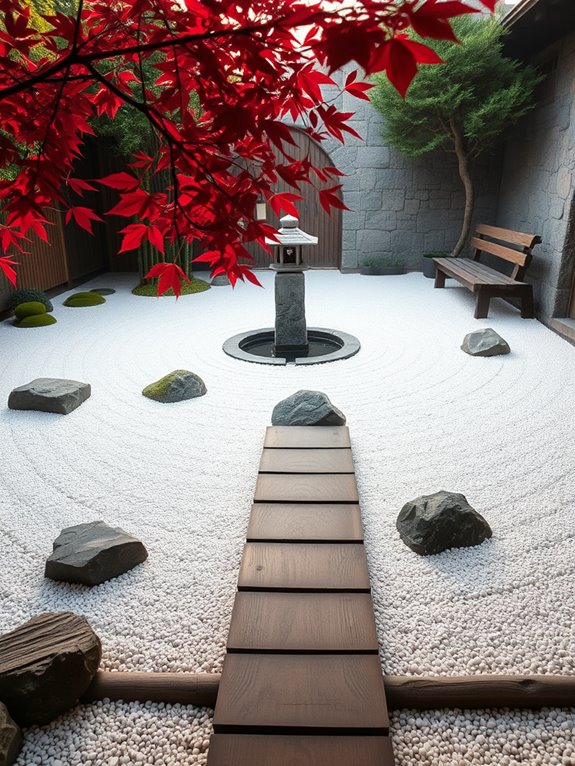
Transform your side yard into a tranquil Zen meditation garden where carefully placed elements create an atmosphere of serenity and mindful contemplation. Smooth river rocks form winding paths through strategically positioned boulders, while meticulously raked gravel patterns ripple outward like waves on a peaceful pond.
Japanese maples cast delicate shadows across the ground, their deep burgundy leaves providing subtle movement and seasonal interest against a backdrop of evergreen shrubs like nandina and bamboo.
The garden’s minimalist design emphasizes negative space, allowing each element to breathe and command attention without overwhelming the senses. A small stone water feature creates gentle sounds that mask urban noise, while carefully pruned cloud-form junipers and moss-covered stones provide textural contrast.
Natural materials in muted earth tones dominate the palette, creating a cohesive environment that encourages meditation and introspection.
Essential Elements:
- Gravel or sand for raking patterns
- Large and medium-sized rocks
- Japanese maple trees
- Bamboo plants
- Cloud-pruned evergreens
- Stone lanterns
- Water feature
- Wooden bench or meditation seat
- Moss gardens
- Stepping stones
- Rake for sand patterns
- Privacy screens or fencing
Implementation begins with clearing the space and establishing proper drainage, followed by installing a weed barrier beneath the gravel areas. Position the largest rocks first, creating focal points and anchor elements that guide the eye through the space.
Install the water feature and any electrical components before adding plants, ensuring proper spacing for mature growth. Layer the design with ground covers like moss between stepping stones, and finish by adding sculptural elements and lighting.
The garden requires regular maintenance to preserve its meditative qualities. Rake the gravel in consistent patterns weekly, trim plants to maintain their shapes, and keep the space free of fallen leaves or debris.
Consider incorporating a simple irrigation system to maintain plant health while preserving the garden’s serene appearance.
When adapting this design for different spaces, focus on scale-appropriate elements. Smaller side yards might use vertical bamboo screens and wall-mounted water features to maximize space, while larger areas can accommodate multiple seating areas and more elaborate rock groupings.
Consider your climate when selecting plants, and remember that authentic Zen gardens often use native species adapted to local conditions. For narrow spaces, use mirrors or light-colored materials to create the illusion of width, and implement asymmetrical design principles to maintain visual interest without cluttering the space.
Install a Vertical Garden Wall
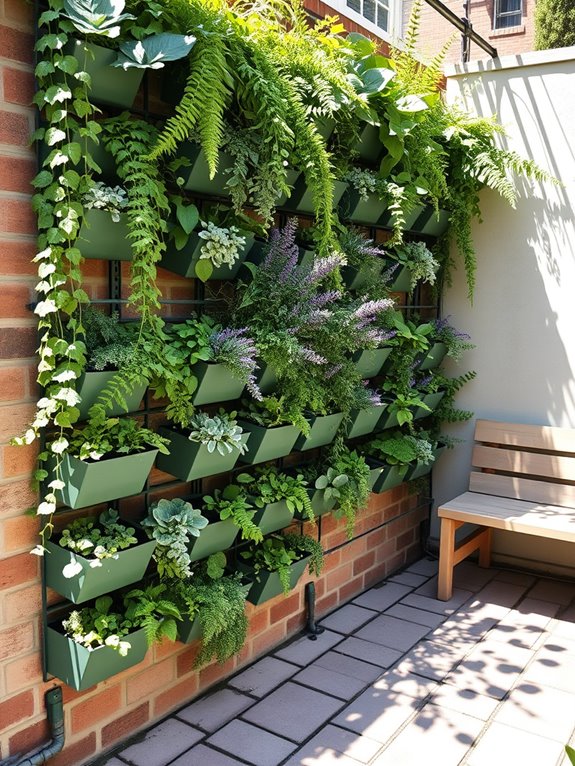
Transform your narrow side yard into a living tapestry with a stunning vertical garden wall. Lush ferns cascade downward while vibrant flowering vines climb skyward, creating an enchanting green canvas that maximizes every inch of vertical space. Delicate succulents nestle between hardy herbs, while compact flowering plants like lobelia and viola add bursts of color throughout the seasons, turning an otherwise mundane wall into a dynamic ecosystem.
The vertical garden brings depth and dimension to your side yard, effectively doubling your growing space while creating an intimate atmosphere. The gentle rustle of leaves and the natural cooling effect of the living wall transform the area into a serene retreat. Mix trailing plants like ivy and jasmine with upright growers such as salvias and lavender to create visual interest and varying textures that catch light and shadow throughout the day.
Key Elements:
- Vertical garden mounting system or panels
- Irrigation system with timer
- Growing medium appropriate for vertical gardens
- Mix of trailing and upright plants
- Support structures and anchoring hardware
- Moisture-resistant backing material
- Drainage collection system
- Plant-specific fertilizers
- Pruning tools
- Weather-resistant containers or pocket planters
Begin installation by securing a moisture-resistant backing to your wall, followed by mounting the vertical garden system according to manufacturer specifications. Install the irrigation system before adding growing medium and plants, ensuring even water distribution throughout the structure.
Position plants strategically, placing drought-tolerant varieties at the top where water drains quickly, and moisture-loving plants toward the bottom. Consider plant mature sizes and growth patterns when spacing, typically allowing 6-12 inches between plants depending on species.
For optimal success, choose plants based on your wall’s sun exposure and local climate. Incorporate slow-release fertilizers into the growing medium and establish a regular maintenance schedule for pruning and system checks. Monitor water flow and drainage carefully during the first few weeks, adjusting irrigation timing as needed.
For areas with harsh winters, select cold-hardy plants or consider temporary protection during extreme weather. The beauty of vertical gardens lies in their adaptability – even the smallest side yard can accommodate this growing style.
For narrow spaces, opt for shallow-rooted plants and slim-profile mounting systems. Consider incorporating built-in lighting to highlight your living wall after dark, and install your garden in sections if budget or maintenance concerns arise. Remember to account for mature plant size and provide adequate air circulation between plants to prevent fungal issues.
Build a Practical Storage Space
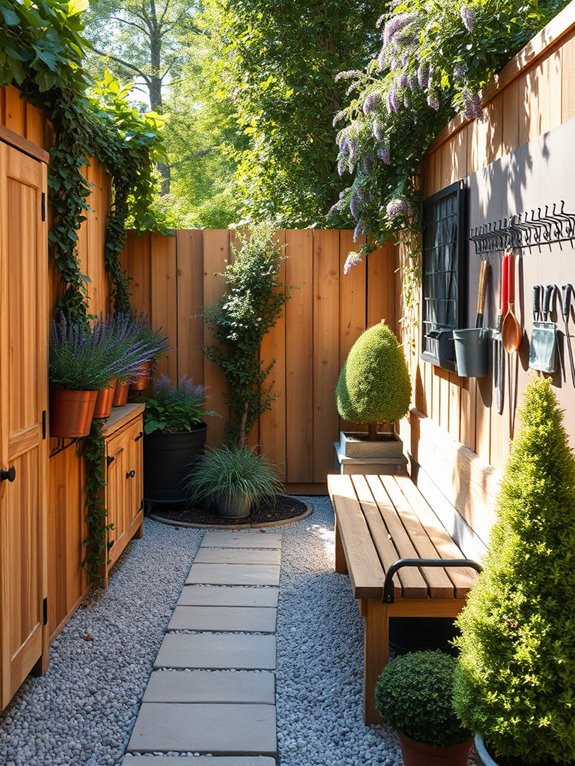
Transform your side yard into a stylish and functional storage space that seamlessly blends practicality with natural beauty. Wooden storage cabinets and sleek metal shelving units peek out from behind a carefully curated collection of climbing vines like Virginia creeper and jasmine, creating an enchanting fusion of purpose and aesthetics.
Decorative trellises adorned with flowering clematis provide natural screening, while compact evergreen shrubs like boxwood and dwarf conifers add structure and year-round greenery.
Stone pathways wind between raised garden beds filled with ornamental grasses and hardy perennials, leading to organized storage zones cleverly disguised by strategic plantings. Weather-resistant storage benches double as seating areas, their tops adorned with potted herbs and seasonal flowers.
The overall effect is one of organized charm, where garden tools, outdoor equipment, and household overflow find their home amid a lush, living backdrop.
Essential Elements:
- Weather-resistant storage cabinets or shelving units
- Climbing vines and trellises
- Evergreen screening plants
- Stone or gravel pathways
- Storage benches with seating
- Raised garden beds
- Ornamental grasses
- Compact shrubs
- Tool hooks and hanging systems
- Weather-proof containers
Begin implementation by mapping out distinct zones for different storage needs, ensuring easy access while maintaining visual appeal.
Install weather-resistant storage units against walls or fences, then establish a framework of trellises and support structures for climbing plants. Create a permeable surface using gravel or stepping stones for drainage and accessibility. Position larger storage elements first, then layer in plants, starting with structural evergreens and working outward to softer, more ornamental species.
When planning your storage garden, consider vertical space as valuable real estate. Install hooks, pegboards, or wall-mounted systems behind vine coverage for frequently used tools.
For smaller side yards, opt for narrow storage solutions and climbing plants that grow upward rather than outward. Consider incorporating fold-down tables or collapsible storage units to maximize flexibility in tight spaces, and choose plants that maintain their aesthetic appeal through multiple seasons while requiring minimal maintenance.
Transform Into a Secret Reading Nook
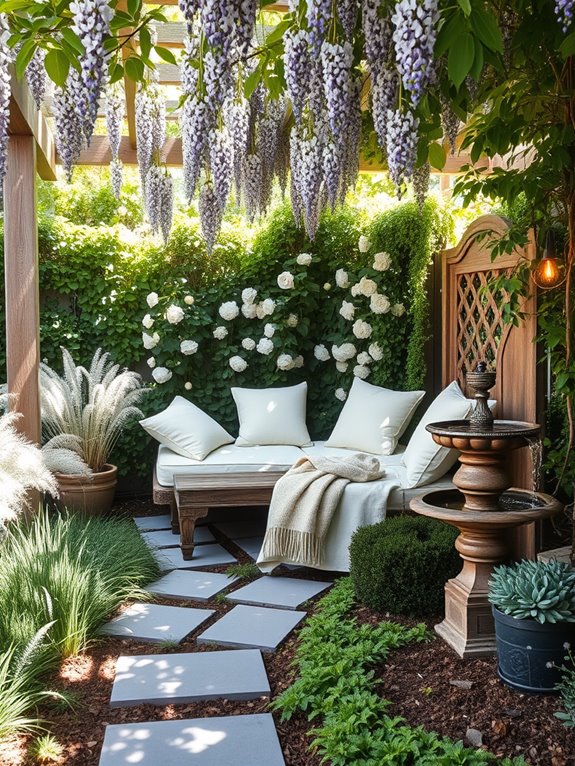
Transform a forgotten side yard into an enchanting reading sanctuary where climbing vines and soft foliage create natural walls of privacy.
Imagine a cozy corner outfitted with a weatherproof chaise lounge or vintage bench nestled beneath the dappled shade of ornamental trees. Fragrant jasmine and climbing roses weave through lattice panels, while potted lavender and chamomile release calming scents with every gentle breeze.
The space comes alive with textural contrast from tall ornamental grasses that sway gracefully, creating a sense of movement and peace. A small water feature adds gentle background sounds, while strategic lighting allows for evening reading sessions.
Stepping stones lead to this private retreat, flanked by shade-loving ferns and hostas that provide ground coverage and create an immediate sense of escape from the outside world.
Key Elements:
- Comfortable seating (weatherproof chaise or bench)
- Climbing vines (jasmine, roses, clematis)
- Privacy screens or lattice panels
- Shade trees or large shrubs
- Path or stepping stones
- Ambient lighting (solar lights, string lights)
- Small water feature
- Fragrant plants (lavender, chamomile)
- Shade-loving ground cover
- Weather-resistant side table
- Outdoor cushions and throws
- Container plants
Begin implementation by installing privacy screens or lattice panels along existing fences or walls, ensuring they’re securely anchored.
Create a level surface for seating using pavers or decking, positioning the main seating area to maximize natural shade and privacy.
Install climbing supports for vines, allowing adequate space for growth, and plant shade-tolerant species in layers, with taller plants at the back and shorter ones in front.
Add lighting at various heights to create ambiance and functionality.
When designing your reading nook, consider seasonal changes and maintenance requirements.
Choose plants that provide year-round interest and vary bloom times to maintain visual appeal.
Ensure adequate drainage around seating areas, and select materials that can withstand local weather conditions.
For smaller spaces, utilize vertical gardening techniques and multi-functional furniture pieces that can provide both seating and storage.
Consider incorporating mirrors to create the illusion of more space and reflect garden features, and use containers on wheels for flexibility in arrangement.
Add a Whimsical Container Garden
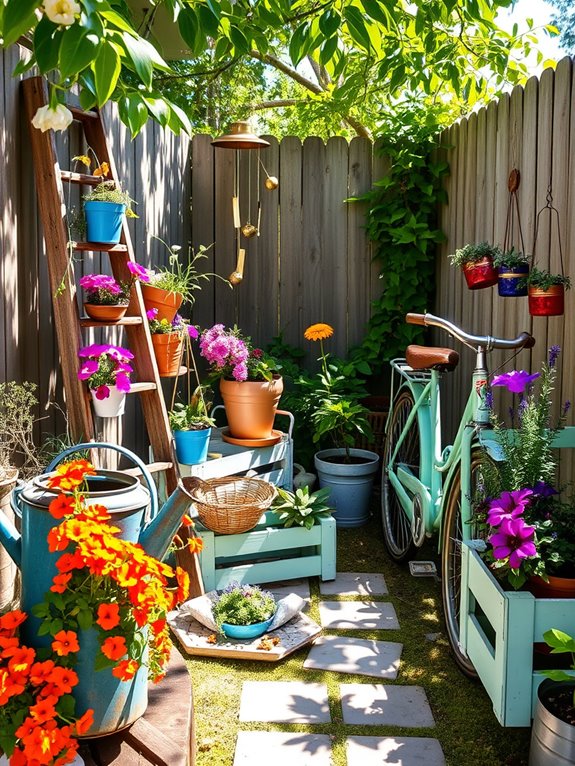
Transform your side yard into a playful oasis with a whimsical container garden that delights the senses and sparks imagination. Mismatched vintage containers, from weathered wooden crates to antique watering cans and colorful ceramic pots, create an enchanting display filled with cascading flowers and quirky plant combinations.
Trailing nasturtiums spill over the edges of elevated containers, while cheerful zinnias and dahlias stand tall in repurposed milk jugs, creating varying heights and visual interest throughout the space.
The eclectic collection of containers allows for experimentation with unexpected plant groupings and creative vertical displays. Incorporate found objects like old ladders or bicycle frames as plant stands, and hang mason jar planters filled with herbs and miniature succulents.
Add whimsical touches like painted garden stakes, colorful wind chimes, and metal butterfly sculptures to enhance the magical atmosphere and create movement throughout the garden.
Key Elements:
- Variety of containers (vintage, repurposed, ceramic)
- Mixed flowering plants
- Trailing vines
- Vertical display structures
- Garden art and sculptures
- Wind chimes
- Decorative stakes
- Plant stands
- Hanging planters
- Herbs and succulents
Begin implementation by selecting a diverse collection of containers with proper drainage holes, arranging them in groups of odd numbers to create visual impact.
Position larger containers toward the back and sides of the space, with smaller ones in front to create depth. Ensure all containers have quality potting soil and are placed to allow adequate air circulation between plants.
Install shepherd’s hooks or mount brackets on nearby walls for hanging planters, and position vertical structures to maximize growing space without overcrowding.
For maximum impact and sustained interest, consider these adaptations: In narrow side yards, focus on vertical arrangements and wall-mounted containers to maximize space. For wider areas, create meandering pathways between container groupings.
Ensure proper irrigation by installing drip systems or self-watering containers, especially in hot climates. Consider using lightweight containers or placing heavier ones on rolling platforms for easier maintenance access.
Scale the size and number of containers to match your available space, and rotate seasonal plants to maintain year-round interest.
